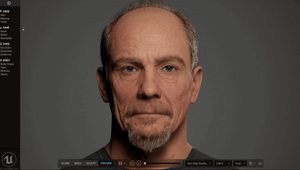
The VR State Of The Union

This year, CES was the launching ground for many new Head Mounted Displays (HMDs) offering improved wireless technology, super-high resolution displays, and new forms of eye-tracking.
While 2018 is the year many of these technologies will land, unfortunately they are not all coming together in one headset, and at the reduced price necessary for mass adoption. Nevertheless, we are going to see a significant leap forward.
Here’s a run-down of the technologies and HMDs we’re excited about.
Wireless Headsets
There’s nothing worse than having your sense of presence broken by having to step over a cable; hyperbolic, perhaps, but it does have an impact on immersion. So wireless VR is a dream come true, but there are two problems with going wireless: power and latency.
Could the recently announced HTC VIVE Wireless Adapter solve these issues? It’s going to work on the base model and VIVE Pro (more on that soon) and features Intel’s WiGig technology. It promises a premium VR wireless experience that operates in the mostly interference-free 60GHz band. This means lower latency and better performance. However, you’ll need a battery to power the wireless system, and the headset. The battery is part of the headset strap in both the HTC and TP-Cast implementations, which increases the headset weight and bulk.
The 60GHz technology is very susceptible to interference, if the line of sight between transmitter and receiver is interrupted. This combined with directional antennas mean that transmitter placement is critical to a smooth experience; in reality this means mounting the transmitter above your play space in the middle to ensure even coverage.
Frank Soqui, General Manager Virtual Reality Group at Intel Corporation says, “Wireless VR has been on nearly every VR user’s wishlist since the technology was unveiled. By collaborating with HTC to commercialise Intel’s WiGig technology, we will guarantee that wireless VR meets the most discerning quality bar for home users and business VR customers.”
The Vive Wireless Adapter will be available to buy in Q3 2018, price TBC.
The alternate approach is standalone systems, with both the battery and the processing within the headset, it would remove the need for a more expensive PC whilst enabling the user to cut the cord out entirely. Speaking of standalone systems…
Lower Cost, Standalone Headsets
The Oculus Go is coming. Facebook’s standalone VR headset starts at just $200, and this price point looks set to open up the VR market to a far wider range of users. With the full backing of the Zuckerberg Empire, and a store set to launch with over a thousand apps, it’s going to be a great entry point for those looking to experience VR for the first time. This headset, like the Gear VR before it and the standard Google Daydream, is only 3DoF.
While it’s coming in at a slightly higher price point, the Lenovo Mirage Solo is a strong offering. Not only is it the first standalone Google Daydream headset, but it is powered by Google’s WorldSense platform, allowing for 6DoF movement without any of those pesky cables to worry about.
VIVE has the Focus, but currently, it’s only available in China. Both this headset and the Lenovo are based around the Qualcomm® Snapdragon™ 835 reference design showcased last year. Making use of SLAM tracking camera’s to track the headset’s movement in space.
Inside-Out Tracking
The Lenovo and Focus aren’t the only headsets with inside-out tracking powering the movement. The Windows Mixed Reality headsets currently on the market also support the tracking technology, moving tethered VR headsets past the point we’re currently at with the Rift and VIVE, as far as convenience goes. These newer headsets feature a cut down version of the sensor suit from the HoloLens, allowing the technology to accurately place itself within the physical space around it, allowing for more precise positioning. They can even track hand controllers, as long as they are within the headsets field of view. This removes the need for the VIVE’s Lighthouse units or Rift trackers, as the headset does all of the work! Oculus recently showed off their Santa Cruz prototype, which allows for 6DoF tracking without any cables, seemingly in a similar way to the Lenovo Mirage Solo. However, there is another technology that will greatly enhance the user experience...
Eye-Tracking
Not only is eye-tracking set to heighten the user experience, it will also lead to higher-quality experiences overall. When implemented in a VR headset, eye-tracking can enable ‘foveated’ rendering, which allows the portion of the screen you’re looking at to be rendered in high quality while the peripheral sections are rendered at a lower quality, every frame. In essence, the headset understands where the user is looking, and draws the details in front of their eyes with higher clarity, while lowering the resolution of the render in your peripheral vision.
Early versions of foveated rendering have been used in VR experiences that are already on the market, but this is more of an aftermarket version of the technology retrofitted to existing headsets.
Higher Resolutions
The most noticeable upgrade to anyone using a current generation VR headset will be higher resolution screens. Samsung’s Windows Mixed Reality headset has higher resolution screens than any other WMR headset currently on the market.The upcoming Vive Pro has a markedly higher resolution than the standard Vive, comparable with the best Samsung. Pimax has kickstarted their ‘8K’ and ‘5K VR’ headsets, and these higher-resolutions are likely only to come in to play as eye-tracking becomes more prominent, because as resolutions go up, so will system requirements. The end result of these increased resolutions will be that you’ll notice more detail in all of the right places, putting less strain on the computational hardware to boot!
Undeniably, these VR developments are carving the path to mass adoption, but without awareness and desire, we’re never going to get there. The upcoming release of Spielberg’s upcoming Ready Player One will play a huge role in creating mass awareness. And when people ask ‘when will we have that’, we’ll be able to give them a clearer answer; ‘sooner than you think.’










